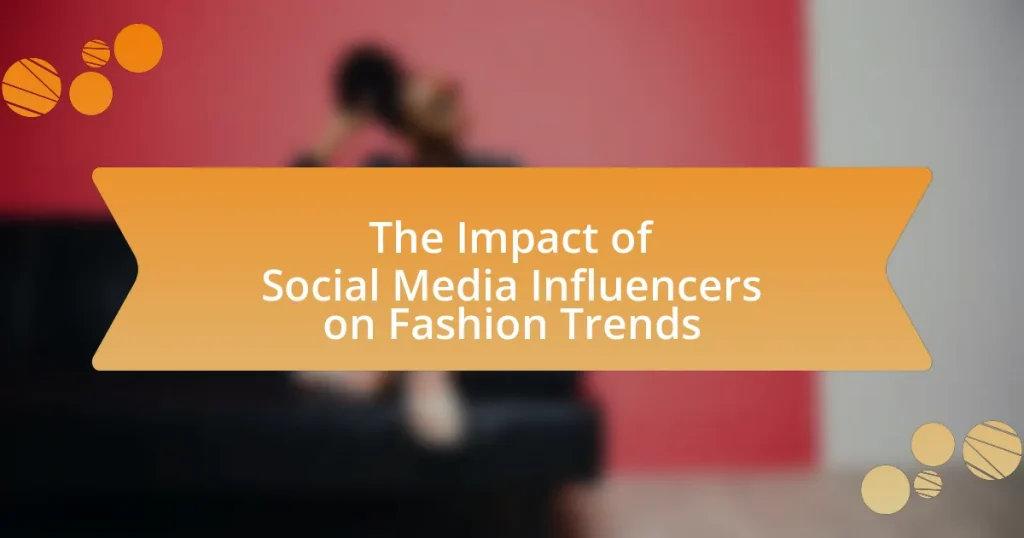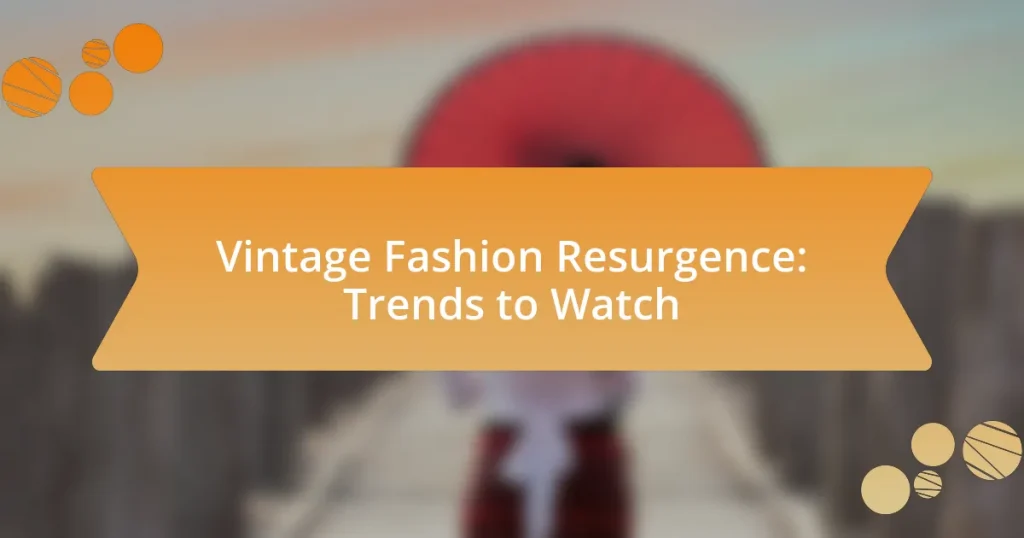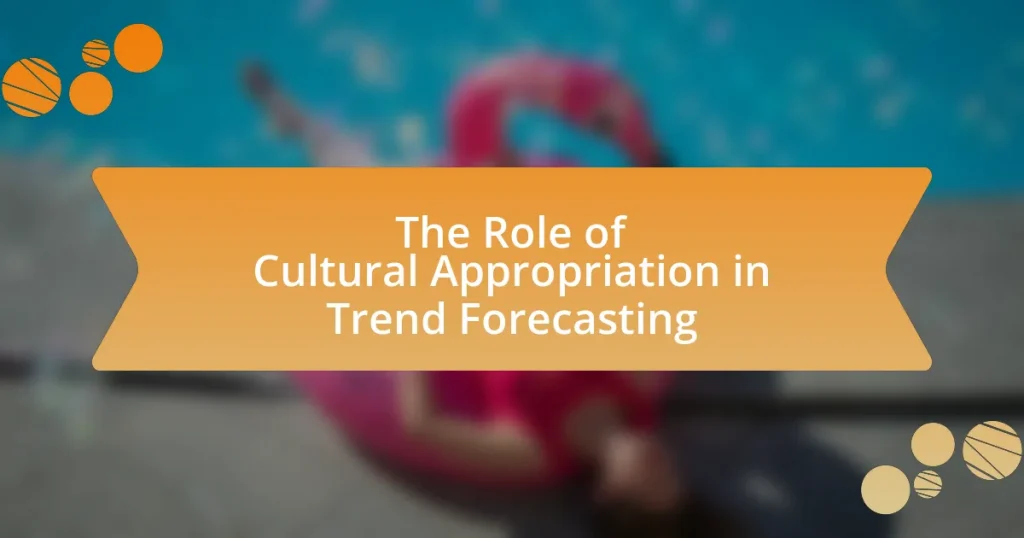Social media influencers play a pivotal role in shaping fashion trends by utilizing their extensive followings to promote styles and brands, significantly impacting consumer behavior and purchasing decisions. Research indicates that a substantial percentage of consumers rely on influencer recommendations, highlighting their authority and trustworthiness in the fashion industry. The article explores the psychological factors influencing followers’ decisions, the creation of community around fashion trends, and the effectiveness of various social media platforms in influencer marketing. Additionally, it examines the characteristics of successful influencers, the benefits and challenges for fashion brands collaborating with them, and emerging trends such as sustainability and the rise of micro-influencers.
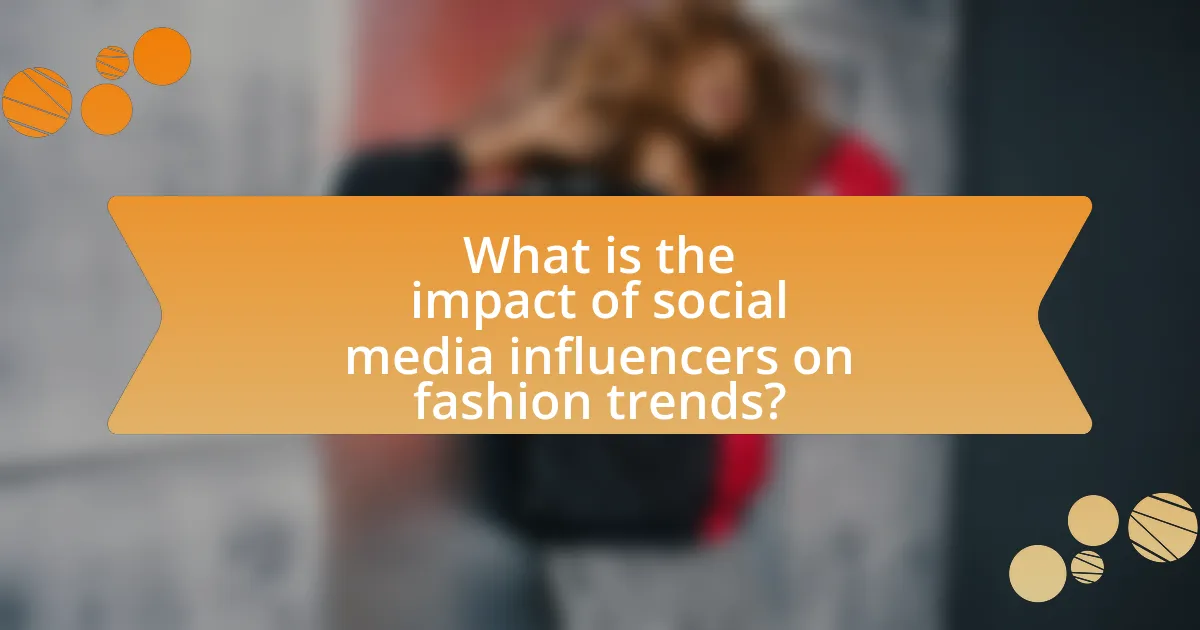
What is the impact of social media influencers on fashion trends?
Social media influencers significantly shape fashion trends by leveraging their large followings to promote styles and brands. Their ability to reach millions of followers creates a direct line of communication between brands and consumers, often leading to rapid adoption of new trends. For instance, a study by the American Marketing Association found that 49% of consumers rely on influencer recommendations for their purchasing decisions, highlighting the influencers’ role in driving fashion choices. Additionally, platforms like Instagram and TikTok allow influencers to showcase outfits in real-time, further accelerating trend cycles and encouraging immediate consumer engagement.
How do social media influencers shape consumer behavior in fashion?
Social media influencers shape consumer behavior in fashion by leveraging their reach and credibility to promote brands and products, significantly impacting purchasing decisions. Research indicates that 49% of consumers rely on influencer recommendations for their fashion purchases, highlighting the trust and authority influencers hold over their followers. Additionally, influencers create a sense of urgency and exclusivity through limited-time promotions and curated content, which can lead to increased sales and brand loyalty. This dynamic is further supported by the fact that 70% of teenagers trust influencers more than traditional celebrities, demonstrating the shift in consumer trust towards social media figures in the fashion industry.
What psychological factors influence followers’ purchasing decisions?
Psychological factors that influence followers’ purchasing decisions include social proof, authority, and emotional appeal. Social proof occurs when individuals look to others’ behaviors and opinions to guide their own choices, often leading them to purchase products endorsed by influencers. Authority is established when followers perceive influencers as credible sources, which can significantly sway their buying behavior; studies show that 92% of consumers trust recommendations from individuals over brands. Emotional appeal plays a crucial role as well, as influencers often create relatable content that resonates with followers’ feelings, driving them to make purchases based on emotional connections rather than just product features.
How do influencers create a sense of community around fashion trends?
Influencers create a sense of community around fashion trends by actively engaging their followers through interactive content and personalized communication. They utilize platforms like Instagram and TikTok to share styling tips, host live Q&A sessions, and encourage user-generated content, fostering a participatory environment. For instance, influencers often initiate challenges or hashtag campaigns that invite followers to showcase their interpretations of a trend, which not only promotes inclusivity but also strengthens the bond among community members. This engagement strategy is supported by research indicating that 79% of consumers say user-generated content highly impacts their purchasing decisions, highlighting the effectiveness of community-driven interactions in the fashion space.
What role do social media platforms play in fashion influencer marketing?
Social media platforms are essential in fashion influencer marketing as they provide the primary channels for influencers to reach and engage with their audiences. These platforms, such as Instagram, TikTok, and Pinterest, enable influencers to showcase fashion products through visually appealing content, driving brand awareness and consumer interest. According to a 2021 survey by the Digital Marketing Institute, 49% of consumers rely on influencer recommendations for their purchasing decisions, highlighting the effectiveness of social media in influencing consumer behavior. Additionally, the interactive features of these platforms, such as comments, likes, and shares, facilitate direct engagement between influencers and their followers, further enhancing the marketing impact.
Which platforms are most effective for fashion influencers?
Instagram and TikTok are the most effective platforms for fashion influencers. Instagram’s visual-centric design allows influencers to showcase outfits and styles through high-quality images and stories, attracting over 1 billion monthly active users, with 67% of users stating they discover new products on the platform. TikTok, with its rapidly growing user base of over 1 billion, emphasizes short, engaging videos that can go viral, making it ideal for fashion trends and challenges. Both platforms facilitate direct engagement with audiences, enhancing brand partnerships and driving sales in the fashion industry.
How do algorithms affect the visibility of fashion content?
Algorithms significantly influence the visibility of fashion content by determining which posts are shown to users based on their engagement patterns. Social media platforms like Instagram and TikTok utilize algorithms that prioritize content with higher interaction rates, such as likes, comments, and shares, thereby amplifying the reach of popular fashion influencers. For instance, a study by the Pew Research Center found that 70% of users are more likely to engage with content that appears in their personalized feeds, which are curated by algorithms. This means that fashion content that resonates with a specific audience is more likely to be promoted, leading to increased visibility and potential virality.
What are the key characteristics of successful fashion influencers?
Successful fashion influencers possess authenticity, strong visual aesthetics, and effective engagement skills. Authenticity allows them to build trust with their audience, as followers are more likely to connect with influencers who present genuine lifestyles and opinions. Strong visual aesthetics are crucial, as fashion is inherently visual; influencers must curate appealing content that showcases their style and resonates with their audience. Effective engagement skills, including responding to comments and fostering community interaction, enhance their influence and loyalty among followers. These characteristics are supported by studies indicating that authenticity and engagement significantly impact follower trust and brand partnerships in influencer marketing.
What skills do influencers need to effectively promote fashion trends?
Influencers need strong communication skills to effectively promote fashion trends. These skills enable them to articulate their thoughts clearly, engage their audience, and convey the essence of the fashion trends they are endorsing. Additionally, influencers must possess a keen understanding of social media platforms, as each platform has unique features and audience demographics that influence how fashion content is received.
Moreover, creativity is essential for influencers to develop visually appealing content that captures attention and resonates with their followers. They also need to have a good sense of style and trend awareness to curate outfits and accessories that align with current fashion movements. Finally, analytical skills are important for influencers to assess engagement metrics and adapt their strategies based on audience feedback and trends in the fashion industry.
How does authenticity impact an influencer’s success in fashion?
Authenticity significantly enhances an influencer’s success in fashion by fostering trust and relatability among their audience. When influencers present themselves genuinely, they are more likely to resonate with followers, leading to higher engagement rates and brand loyalty. Research indicates that 86% of consumers consider authenticity important when deciding which brands to support, highlighting the direct correlation between an influencer’s perceived authenticity and their effectiveness in promoting fashion trends. This trust translates into increased sales and a stronger influence on consumer purchasing decisions, as followers are more inclined to emulate the styles and products endorsed by influencers they perceive as authentic.
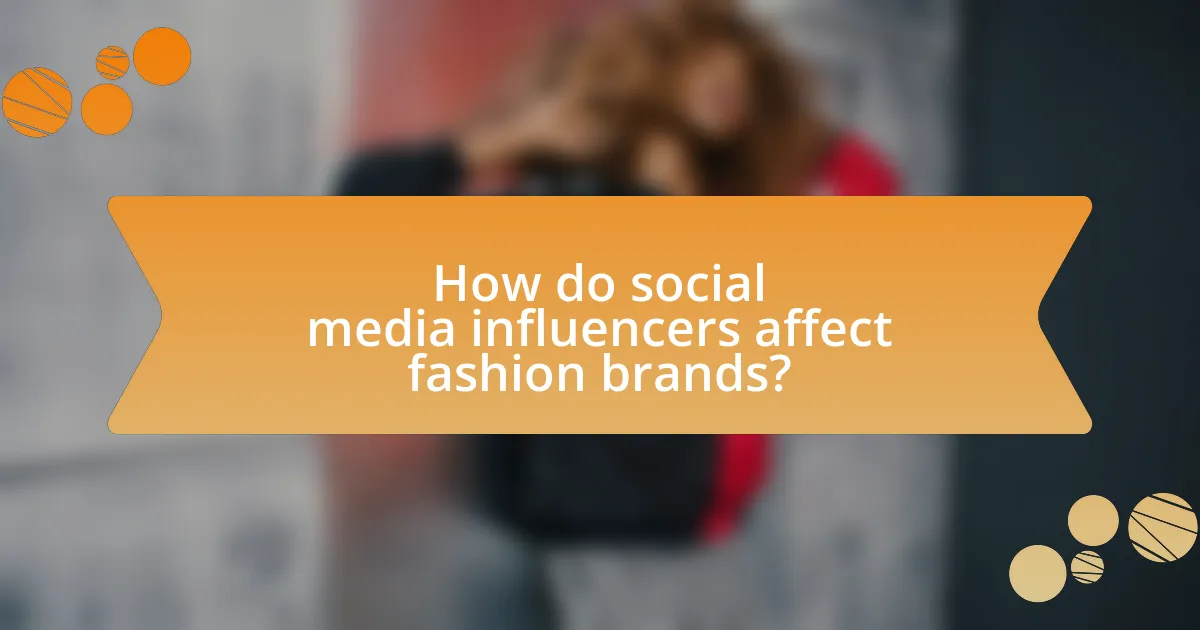
How do social media influencers affect fashion brands?
Social media influencers significantly affect fashion brands by shaping consumer perceptions and driving purchasing decisions. Influencers leverage their large followings to promote brands, often leading to increased visibility and sales. For instance, a study by the Digital Marketing Institute found that 49% of consumers depend on influencer recommendations when making purchasing decisions. Additionally, brands that collaborate with influencers can see a return on investment of up to $6.50 for every dollar spent on influencer marketing, according to a report by Influencer Marketing Hub. This demonstrates that influencers not only enhance brand awareness but also directly contribute to financial success for fashion brands.
What benefits do fashion brands gain from collaborating with influencers?
Fashion brands gain increased visibility and credibility by collaborating with influencers. Influencers have established trust and a loyal following, which allows brands to reach targeted audiences effectively. For instance, a study by the Digital Marketing Institute found that 49% of consumers depend on influencer recommendations when making purchase decisions. Additionally, collaborations often lead to higher engagement rates on social media, as posts featuring influencers can generate up to 10 times more engagement than traditional advertising. This enhanced engagement translates into increased brand awareness and potential sales growth for fashion brands.
How do influencer partnerships enhance brand visibility?
Influencer partnerships enhance brand visibility by leveraging the influencer’s established audience and credibility to reach potential customers. When brands collaborate with influencers, they gain access to a targeted demographic that trusts the influencer’s recommendations, leading to increased brand awareness and engagement. For instance, a study by the Digital Marketing Institute found that 49% of consumers depend on influencer recommendations when making purchasing decisions, demonstrating the effectiveness of these partnerships in driving visibility and sales.
What impact do influencers have on brand loyalty and trust?
Influencers significantly enhance brand loyalty and trust by creating authentic connections with their audience. Their ability to share personal experiences and recommendations fosters a sense of reliability and relatability, which consumers often seek. Research indicates that 70% of teenagers trust influencers more than traditional celebrities, highlighting the effectiveness of influencers in building trust. Additionally, a study published in the Journal of Marketing Research found that consumers are more likely to remain loyal to brands endorsed by influencers they follow, as these endorsements often lead to increased perceived credibility and emotional engagement with the brand.
What challenges do fashion brands face when working with influencers?
Fashion brands face several challenges when working with influencers, including authenticity issues, alignment of brand values, and measuring return on investment (ROI). Authenticity is crucial, as consumers are increasingly skeptical of influencer promotions; a study by the Digital Marketing Institute found that 49% of consumers rely on influencer recommendations, but only if they perceive them as genuine. Additionally, brands must ensure that the influencer’s audience aligns with their target demographic; mismatched partnerships can lead to ineffective campaigns. Finally, quantifying the impact of influencer collaborations on sales and brand awareness remains complex, with 60% of marketers reporting difficulties in measuring ROI from influencer marketing, according to a survey by Influencer Marketing Hub.
How can brands ensure alignment with an influencer’s image?
Brands can ensure alignment with an influencer’s image by conducting thorough research on the influencer’s content, values, and audience engagement. This involves analyzing the influencer’s previous collaborations, the themes they promote, and their overall aesthetic to confirm compatibility with the brand’s identity. For instance, a study by Influencer Marketing Hub found that 63% of marketers believe that aligning with the right influencer can significantly enhance brand credibility. By selecting influencers whose personal brand resonates with their target demographic, brands can create authentic partnerships that enhance their image and reach.
What risks are associated with influencer marketing in fashion?
Influencer marketing in fashion carries several risks, including brand reputation damage, lack of authenticity, and regulatory compliance issues. Brand reputation can be jeopardized if an influencer engages in controversial behavior or promotes products that do not align with the brand’s values, leading to consumer backlash. Lack of authenticity arises when influencers promote products solely for financial gain rather than genuine belief, which can erode trust among followers. Regulatory compliance issues, such as failing to disclose paid partnerships, can result in legal penalties and further harm a brand’s image. According to a 2021 survey by the Digital Marketing Institute, 61% of consumers are less likely to trust brands that do not disclose influencer partnerships, highlighting the importance of transparency in influencer marketing.
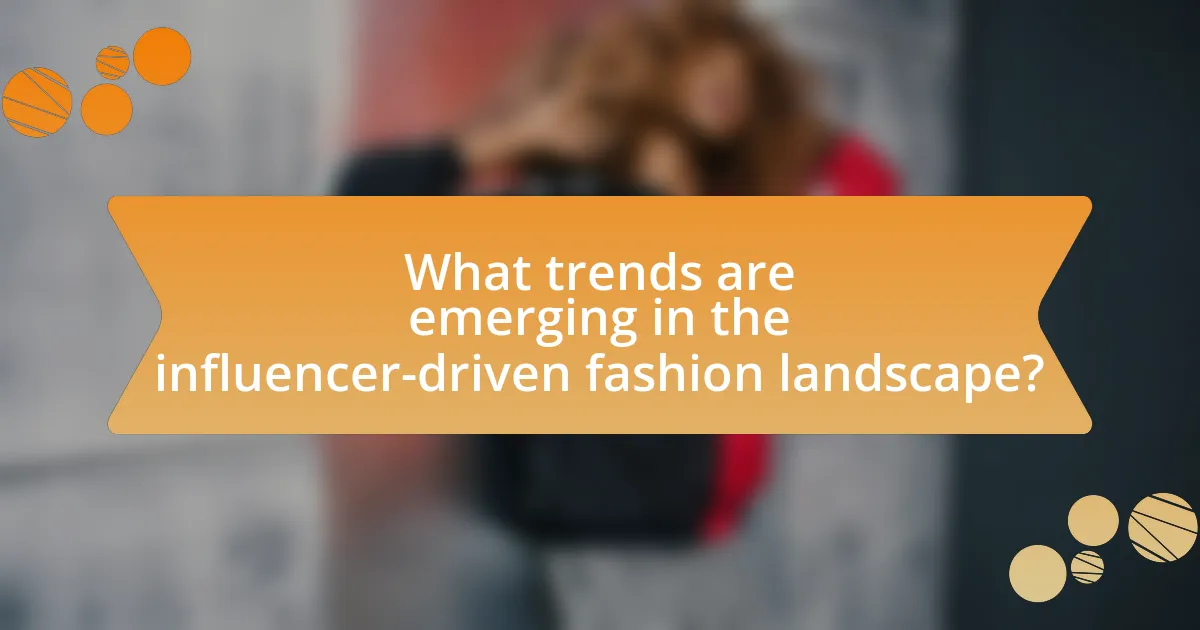
What trends are emerging in the influencer-driven fashion landscape?
Emerging trends in the influencer-driven fashion landscape include a shift towards sustainable fashion, increased personalization, and the rise of micro-influencers. Sustainable fashion is gaining traction as influencers promote eco-friendly brands and practices, reflecting consumer demand for ethical choices; for instance, a 2022 survey indicated that 66% of consumers prefer sustainable brands. Personalization is also on the rise, with influencers curating unique styles that resonate with their followers, leading to a more individualized shopping experience. Additionally, micro-influencers, who often have smaller but highly engaged audiences, are becoming increasingly influential, as brands recognize their ability to drive authentic engagement and conversions.
How are micro-influencers changing the fashion marketing game?
Micro-influencers are transforming the fashion marketing landscape by fostering authentic connections with niche audiences. Their smaller follower counts, typically ranging from 1,000 to 100,000, allow for higher engagement rates, with studies showing that micro-influencers can achieve engagement rates of up to 7% compared to the 1-3% average of larger influencers. This increased engagement leads to more effective brand partnerships, as consumers often perceive micro-influencers as more relatable and trustworthy. Additionally, brands are increasingly allocating marketing budgets to collaborate with micro-influencers, recognizing that these partnerships can yield a higher return on investment, with a report from Influencer Marketing Hub indicating that businesses earn an average of $5.78 for every dollar spent on influencer marketing.
What advantages do micro-influencers offer to fashion brands?
Micro-influencers offer fashion brands enhanced engagement and authenticity, which are crucial for building trust with consumers. Their smaller, dedicated follower bases often result in higher engagement rates, with studies showing that micro-influencers can achieve engagement rates of up to 7% compared to the 1-3% typical of larger influencers. This higher engagement translates to more meaningful interactions and a stronger connection with the audience, making their endorsements more impactful. Additionally, micro-influencers tend to have a more niche focus, allowing fashion brands to target specific demographics effectively, leading to better conversion rates and a more loyal customer base.
How do niche markets benefit from micro-influencer collaborations?
Niche markets benefit from micro-influencer collaborations by gaining targeted exposure and authentic engagement with specific audiences. Micro-influencers typically have a smaller but highly engaged following, often consisting of individuals who share a common interest or demographic, which allows brands to reach potential customers more effectively. For instance, a study by the Digital Marketing Institute found that micro-influencers can achieve engagement rates of up to 7%, significantly higher than the 1-3% average for larger influencers. This heightened engagement leads to increased brand loyalty and conversion rates, as consumers are more likely to trust recommendations from influencers who resonate with their specific interests and values.
What future predictions can be made about social media influencers in fashion?
Social media influencers in fashion are predicted to increasingly shape consumer behavior and brand strategies through enhanced engagement and authenticity. As platforms evolve, influencers will leverage advanced technologies like augmented reality and artificial intelligence to create immersive shopping experiences, driving higher conversion rates. According to a 2022 report by McKinsey, 70% of consumers are influenced by social media when making fashion purchases, indicating a growing reliance on these figures for trend-setting. Additionally, the rise of niche influencers will diversify fashion marketing, allowing brands to target specific demographics more effectively, as evidenced by the 2023 trend analysis from Statista, which shows a 30% increase in engagement rates for micro-influencers compared to traditional celebrity endorsements.
How might technology influence the evolution of fashion influencers?
Technology will significantly influence the evolution of fashion influencers by enhancing their reach and engagement through advanced digital platforms. The rise of social media algorithms allows influencers to target specific audiences more effectively, increasing their visibility and impact on fashion trends. For instance, platforms like Instagram and TikTok utilize data analytics to promote content that resonates with users, leading to a more personalized experience. Additionally, augmented reality (AR) and virtual reality (VR) technologies enable influencers to create immersive experiences, allowing followers to visualize clothing in a virtual environment, which can drive purchasing decisions. According to a report by McKinsey & Company, the integration of technology in fashion marketing has led to a 30% increase in consumer engagement, demonstrating the tangible effects of technological advancements on influencer dynamics.
What role will sustainability play in influencer-driven fashion trends?
Sustainability will play a crucial role in influencer-driven fashion trends by shaping consumer preferences towards eco-friendly products. Influencers have the power to promote sustainable brands and practices, significantly impacting their followers’ purchasing decisions. For instance, a study by McKinsey & Company found that 67% of consumers consider sustainability when making fashion purchases, indicating a strong market demand for environmentally conscious options. As influencers advocate for sustainable fashion, they not only raise awareness but also drive the industry towards more responsible practices, aligning with the growing consumer expectation for transparency and ethical sourcing.
What best practices should brands follow when engaging with fashion influencers?
Brands should prioritize authenticity and alignment with fashion influencers to maximize engagement and effectiveness. Engaging influencers whose personal style and audience resonate with the brand’s identity fosters genuine connections, leading to higher trust and conversion rates. According to a study by the Digital Marketing Institute, 49% of consumers depend on influencer recommendations, highlighting the importance of selecting influencers who genuinely reflect the brand’s values. Additionally, brands should establish clear communication and expectations regarding deliverables, timelines, and compensation to ensure a smooth collaboration process. This structured approach not only enhances the partnership but also contributes to the overall success of influencer campaigns in driving fashion trends.
